 Basic Rolls
| Basic Rolls & Slides
| Left Hand Logic
| E9th Pickgrips |
Basic Rolls
| Basic Rolls & Slides
| Left Hand Logic
| E9th Pickgrips |
Right Hand Logic | The
Right Hand | The Forward
Roll |
 Right
Hand Logic Right
Hand Logic
To learn to play pedal steel I needed a logical
approach to help me see what was going on. To do this I divided things
into three main sections. They were the physical, the mental, and the
musical. Each of these were then divided into section until there was
an outline that developed. The most important part to me was the right
hand and the picking of the strings. All of the pedals, knee levers,
music theory, fancy gadgets, mental practice, and third strings, really
won't mean anything if you can't place the strings in motion. I started
by looking at the simplest move that could be made on a steel and the
simplest way to convey that message to someone else.
The simplest move is the thumb picking
an open string. In traditional tab we would see all ten strings and
the fret would be marked between two lines. This takes up a lot of space
that we could use to show some additional information. I just simplify
things by showing you only the string that is being used. The right
hand movement is then tabbed right over the line that represents the
string. The left hand movement is on a line below and can be studied
separately from the right hand moves.
 |
This graphic
to the left shows S10 and a line. The line represents string ten.
The T is for the thumb. 1 = the first finger. 2 = the second finger.
The right hand movements are written right over the strings. Below
we see the fret. The purpose is to put the emphasis on the right
hand. By isolating a movement we can build up the muscles and the
coordination that are needed to use the small moves to make up those
great licks you want to play. The left hand is tabbed at the first
fret. |
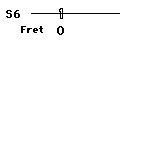 |
The next logical
move to show is the first finger picking a string. To do this we
can change the fret and the string. We still only use one line to
represent the single string that this move takes. Above is the first
finger, picking the 6th string, open. Simple as that. This method
of tablature makes seeing the small things that go together to make
complex licks, at lot easier to deal with. If you go through all
the little things, that combine to play pedal steel, the amount
of information can be overwhelming. Start slow and add things to
the basics and you'll be a better player in the long run. If you're
going through a period in which you don't like your playing, go
back to your right hand and work on things that will make you smoother.
After you get those going, you move on to the left hand. This time
spent at your steel will help you be a better musician. |
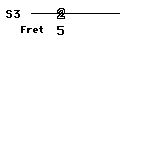 |
The next logical
move above, is to play the second finger on any of our strings.
As you practice a certain picking technique, concentrate on the
movements first. The tone that you are looking for will come to
you when your hands develop the ability to play that tone. Before
you spend the money on a new gadget for your sound, look to the
most important aspect of your playing. Picking the strings. |
A good exercise for each of your picking fingers, is to pick each string
on the guitar. Two ways to practice this is to play one string with
your thumb 25 times. Then do the other two fingers. You can use any
string and should at least get each right hand pick used to picking
all of your strings. For the beginner, this is what you need the most.
The more advanced player can make up drills and exercises that help
to build up that strength and stamina that your right hand needs.
 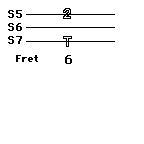 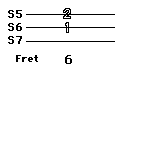
Our three graphics above move ahead in a logical order. We've studied
each finger on its own and now we put the two together. First the thumb
and first finger pick two adjacent strings. We are looking at the groups
of two. As we move on, we can look at all of the possibile groups of
two. Our next graphic is the thumb and second finger. I've given all
of the examples fret markings, but learn to play them on different groups
of strings and at any fret on your guitar. The left
hand is getting a work out helping out the right hand. We will also
study the left hand all by itself. For now concentrate
We
have a total of three combinations of two right hand digits. They are
the thumb and first finger, the thumb and second finger, and the first
and second finger.
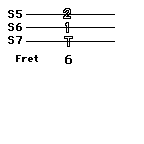 |
We've looked
at them in groups of one, groups of two, and now we need to look
at groups of three. There is only one and it is what I call a pick
grip. Those are studied all by themselves to make them easier to
grasp. |
All of these moves are used at one time or another when you play the
pedal steel. The only thing I do work on them on their own. That way
the right hand doesn't get in the way of left hand learning. Just a
little right hand logic.

|









